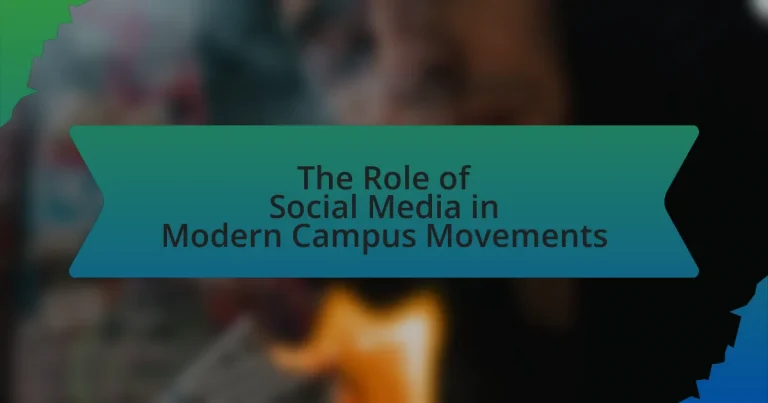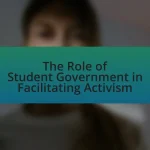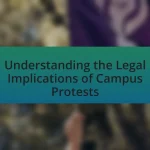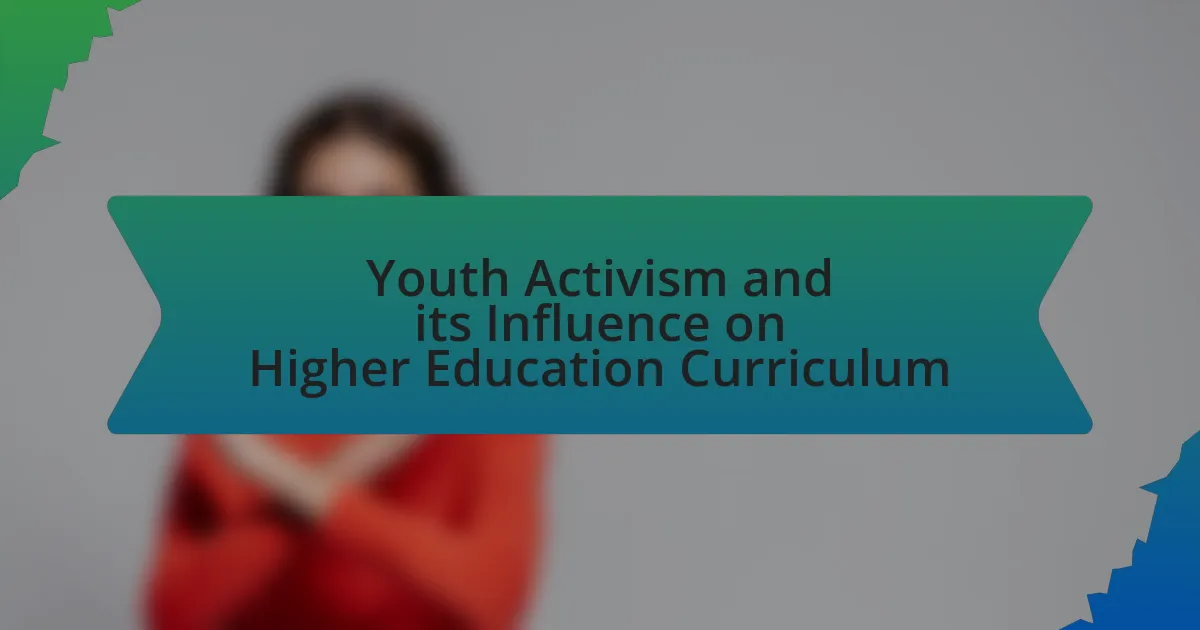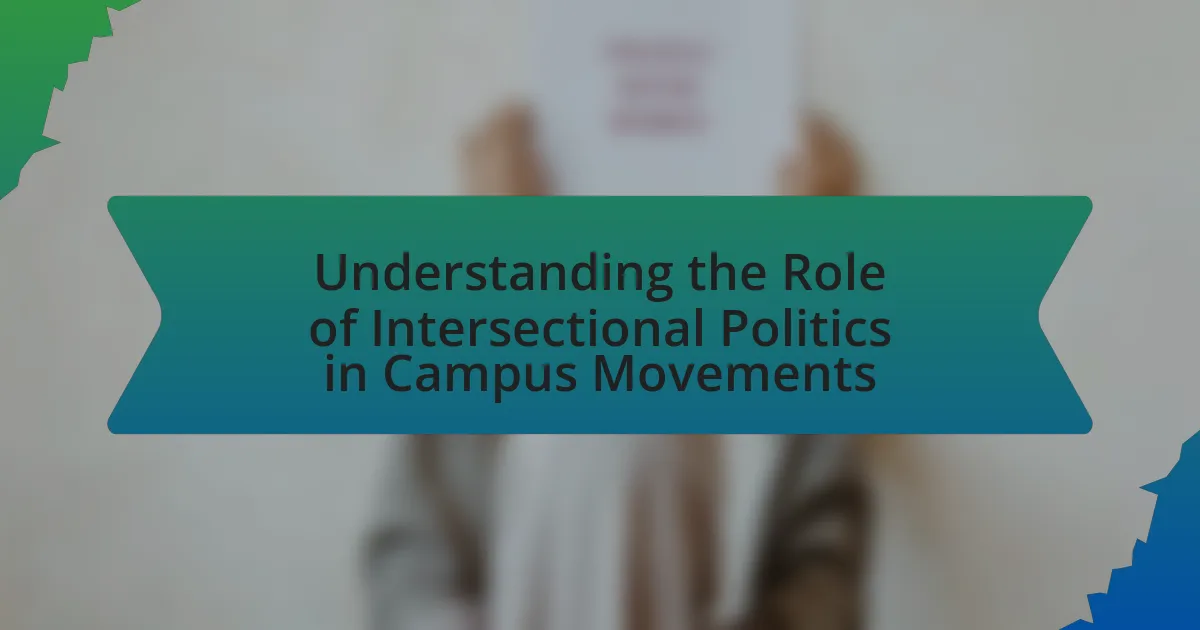The article examines the significant role of social media in modern campus movements, highlighting its impact on communication, organization, and mobilization among students. It discusses how platforms like Twitter, Instagram, and Facebook facilitate rapid information dissemination, community building, and engagement, thereby enhancing student activism. Key features of social media, such as targeted messaging and visual content, are explored, along with the challenges of misinformation, online harassment, and censorship that activists face. The article also addresses future trends in social media’s influence on campus movements and offers practical tips for students to effectively leverage these platforms for advocacy.

What is the Role of Social Media in Modern Campus Movements?
Social media plays a crucial role in modern campus movements by facilitating communication, organization, and mobilization among students. It allows for rapid dissemination of information, enabling students to share their experiences, rally support, and coordinate protests or events effectively. For instance, platforms like Twitter and Instagram have been instrumental in movements such as Black Lives Matter on campuses, where hashtags and viral posts have raised awareness and garnered widespread participation. Research indicates that social media can increase engagement in social movements, with a study by the Pew Research Center showing that 69% of young adults use social media to express their political views. This demonstrates that social media not only amplifies student voices but also fosters a sense of community and solidarity in advocating for change.
How has social media transformed campus activism?
Social media has transformed campus activism by enabling rapid communication, mobilization, and awareness among students. Platforms like Twitter, Facebook, and Instagram allow activists to share information instantly, organize events, and amplify their messages to a broader audience. For instance, the #BlackLivesMatter movement gained significant traction on college campuses through social media, leading to protests and discussions about racial justice. Additionally, studies show that social media engagement increases participation in activism; a 2018 Pew Research Center report indicated that 69% of young adults use social media to express their political views, demonstrating its role in shaping modern campus movements.
What are the key features of social media that facilitate activism?
Key features of social media that facilitate activism include rapid information dissemination, community building, and mobilization capabilities. Rapid information dissemination allows activists to share news and updates instantly, reaching a wide audience quickly; for instance, during the Arab Spring, social media platforms played a crucial role in spreading information about protests and government responses. Community building enables individuals with shared interests to connect and organize, fostering a sense of solidarity; platforms like Facebook and Twitter have been instrumental in creating groups that unite activists around common causes. Mobilization capabilities allow for the organization of events and actions, such as protests and campaigns, often using hashtags to rally support and increase visibility; the #MeToo movement exemplifies how social media can mobilize individuals globally to address issues of sexual harassment and assault.
How do different platforms influence the nature of campus movements?
Different platforms significantly influence the nature of campus movements by shaping communication styles, outreach capabilities, and engagement levels. For instance, platforms like Twitter facilitate rapid dissemination of information and mobilization, allowing movements to gain traction quickly, as seen in the #BlackLivesMatter movement, which utilized Twitter to organize protests and share real-time updates. In contrast, Facebook fosters community building and event organization, enabling groups to create detailed event pages and engage in discussions, which was evident during the student-led protests at the University of California, Berkeley in 2017. Additionally, Instagram’s visual-centric approach allows movements to convey powerful imagery and narratives, enhancing emotional engagement and awareness, as demonstrated by the use of compelling visuals in climate change activism. Thus, the choice of platform directly affects how messages are communicated, how quickly movements can mobilize supporters, and how effectively they can engage with broader audiences.
Why is social media important for student engagement?
Social media is important for student engagement because it facilitates communication, collaboration, and community building among students. Platforms like Facebook, Twitter, and Instagram allow students to share information, organize events, and discuss academic topics in real-time, enhancing their involvement in campus life. Research indicates that 90% of college students use social media, which underscores its role as a primary communication tool in educational settings. Additionally, studies show that students who engage with their peers through social media are more likely to participate in campus activities and feel a sense of belonging, which is crucial for their overall academic success and well-being.
How does social media enhance communication among students?
Social media enhances communication among students by providing instant access to information and facilitating real-time interactions. Platforms like Facebook, Twitter, and Instagram allow students to share ideas, collaborate on projects, and organize events efficiently. Research indicates that 70% of students use social media for academic purposes, which fosters a sense of community and encourages peer support. Additionally, social media enables students to connect with diverse perspectives, enhancing their learning experience and promoting inclusivity within campus movements.
What role does social media play in mobilizing support for causes?
Social media serves as a crucial platform for mobilizing support for causes by facilitating rapid communication and engagement among users. It enables organizations and individuals to share information, rally supporters, and organize events efficiently. For instance, the #BlackLivesMatter movement gained significant traction through social media, where posts and hashtags spread awareness and mobilized protests globally, demonstrating the platform’s power in amplifying voices and fostering community action. Additionally, studies show that social media campaigns can increase participation in social movements, with a 2018 Pew Research Center report indicating that 69% of adults in the U.S. use social media, making it an effective tool for outreach and advocacy.
What challenges do campus movements face on social media?
Campus movements face significant challenges on social media, including misinformation, algorithmic bias, and the potential for online harassment. Misinformation can undermine the credibility of movements, as false narratives can spread rapidly, leading to confusion and division among supporters. Algorithmic bias can limit the visibility of important posts, as social media platforms often prioritize content that generates higher engagement, which may not always align with the goals of the movement. Additionally, online harassment can create a hostile environment for activists, discouraging participation and silencing voices. These challenges can hinder the effectiveness and reach of campus movements, impacting their ability to mobilize support and drive change.
How do misinformation and disinformation impact campus activism?
Misinformation and disinformation significantly undermine campus activism by distorting facts and creating confusion among students. This distortion can lead to misinformed decisions, eroding trust in legitimate movements and hindering collective action. For instance, a study by the Pew Research Center found that 64% of Americans believe that misinformation has a major impact on public discourse, which extends to campus environments where students rely on social media for information. Consequently, when false narratives circulate, they can polarize student groups, divert attention from critical issues, and diminish the overall effectiveness of activism efforts.
What are the risks of online harassment and censorship for activists?
Online harassment and censorship pose significant risks for activists, undermining their ability to advocate for change. Activists often face targeted attacks, including threats, doxxing, and cyberbullying, which can lead to psychological distress and deter participation in movements. Censorship, whether by social media platforms or governmental entities, restricts the dissemination of information and silences dissenting voices, limiting the reach and impact of activist campaigns. For instance, a 2020 report by the Electronic Frontier Foundation highlighted that 70% of activists experienced online harassment, which can lead to decreased engagement and a chilling effect on free expression. These risks not only threaten individual activists but also weaken collective movements by creating an environment of fear and repression.
How do social media campaigns shape public perception of campus issues?
Social media campaigns significantly shape public perception of campus issues by amplifying voices, mobilizing support, and disseminating information rapidly. These campaigns leverage platforms like Twitter, Instagram, and Facebook to create awareness and foster community engagement around specific issues, such as diversity, mental health, or sexual assault. For instance, the #MeToo movement gained traction on college campuses, leading to increased dialogue and policy changes regarding sexual harassment. Research indicates that 70% of college students believe social media influences their views on campus issues, highlighting its role in shaping opinions and driving action.
What strategies can enhance the effectiveness of social media in campus movements?
Utilizing targeted messaging and engaging visuals can significantly enhance the effectiveness of social media in campus movements. Targeted messaging ensures that the content resonates with specific demographics, increasing engagement and participation. For instance, research by the Pew Research Center indicates that 69% of adults use social media, making it a vital platform for outreach. Engaging visuals, such as infographics and videos, can capture attention more effectively than text alone, as studies show that posts with images receive 94% more views. Additionally, leveraging hashtags can create a unified movement identity, facilitating broader reach and community building. These strategies collectively optimize social media’s impact in mobilizing support and fostering dialogue within campus movements.
How can students create compelling content to drive engagement?
Students can create compelling content to drive engagement by focusing on authenticity, storytelling, and visual appeal. Authenticity resonates with audiences, as studies show that 86% of consumers value transparency from brands and creators. By sharing personal experiences and relatable narratives, students can foster a connection with their audience. Additionally, incorporating high-quality visuals, such as images and videos, enhances engagement; research indicates that posts with visuals receive 94% more views than those without. Utilizing interactive elements like polls and questions can further encourage participation, as engagement rates increase when audiences feel involved in the content creation process.
What best practices should be followed for successful online campaigns?
Successful online campaigns should prioritize clear objectives, audience targeting, engaging content, and data analysis. Establishing clear objectives ensures that the campaign has a defined purpose, which is essential for measuring success. Targeting the right audience allows for tailored messaging that resonates, increasing engagement rates. Creating engaging content, such as videos or interactive posts, captures attention and encourages sharing, which is crucial for virality. Finally, analyzing data from the campaign helps in understanding what works and what doesn’t, allowing for adjustments in real-time. According to a study by HubSpot, campaigns with defined goals are 376% more likely to report success, highlighting the importance of these best practices.
What are the future trends of social media in campus movements?
The future trends of social media in campus movements will increasingly focus on real-time mobilization, enhanced engagement through multimedia content, and the use of data analytics for targeted outreach. As seen in recent movements like the Black Lives Matter protests, social media platforms have become essential for organizing events quickly and efficiently, allowing students to coordinate actions in response to pressing issues. Furthermore, the integration of video and live streaming features on platforms like Instagram and TikTok has proven effective in capturing attention and fostering community support, as evidenced by the viral spread of student-led initiatives. Additionally, the application of data analytics will enable campus organizations to identify key demographics and tailor their messaging, enhancing the effectiveness of their campaigns. These trends indicate a shift towards more dynamic and data-driven approaches in leveraging social media for advocacy and activism on campuses.
How might emerging technologies influence student activism?
Emerging technologies significantly influence student activism by enhancing communication, mobilization, and awareness. For instance, social media platforms like Twitter and Instagram allow students to quickly disseminate information, organize events, and rally support for causes. A study by the Pew Research Center in 2021 found that 84% of young adults use social media, which facilitates real-time engagement and amplifies voices that might otherwise go unheard. Additionally, tools like live streaming and online petitions enable broader participation and visibility, making it easier for students to connect with global movements and advocate for change effectively.
What role will social media play in the evolution of campus movements?
Social media will serve as a catalyst for the evolution of campus movements by facilitating rapid communication and mobilization among students. Platforms like Twitter, Instagram, and Facebook enable students to share information, organize events, and amplify their voices on critical issues, leading to increased awareness and participation. For instance, the #BlackLivesMatter movement gained significant traction on college campuses through social media, demonstrating its power to unite students around social justice causes. Additionally, research by the Pew Research Center indicates that 69% of adults use social media, highlighting its pervasive influence and potential to engage a broader audience in campus activism.
What practical tips can students use to leverage social media for activism?
Students can leverage social media for activism by creating engaging content, utilizing hashtags, and collaborating with like-minded individuals. Engaging content, such as videos, infographics, and personal stories, captures attention and encourages sharing, which amplifies the message. Using relevant hashtags increases visibility and connects the activism efforts to broader movements, as seen with the #BlackLivesMatter and #MeToo campaigns, which gained significant traction through social media. Collaborating with others, including student organizations and influencers, can expand reach and foster a sense of community, enhancing the impact of the activism.
